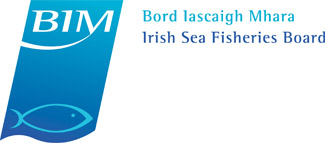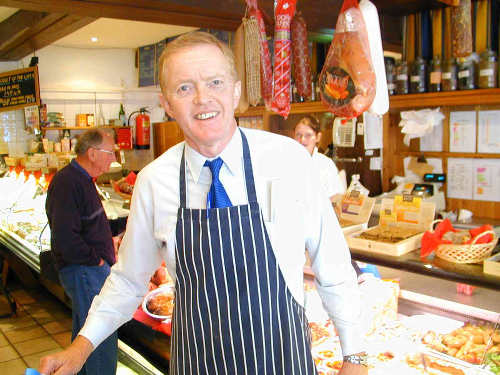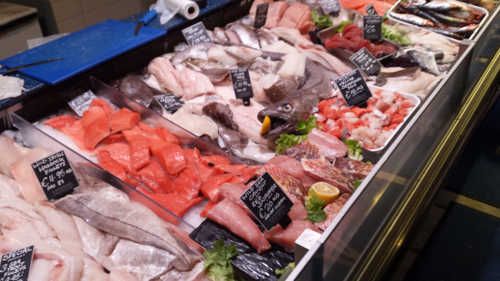The Seafood Interview supported by BIM - Peter Caviston

This month Marilyn Bright talks to one of the Dublin food scene’s most colourful characters, the second generation fishmonger Peter Caviston
The splash of colour that marks out Caviston's in Glasthule’s main street reaches a crescendo at Christmastime, when the tumbling displays of fruits and vegetables and winter greens are garlanded with holly sprigs and glittering wreaths spilling along the footpath.
 No less colourful is proprietor Peter Caviston second generation fishmonger who has now been joined in the business by sons Mark and David. “My father opened the shop in 1947 as a fishmongers and poulterers, which was the traditional pairing in those days - and poultry included game then too,” Peter explains. “Fish was displayed on white slabs in the window, always on ice because there was no refrigeration. Ice was delivered in 56 pound blocks to be crushed, and water was kept trickling down the window as a deterrent for flies. We kept a big vase of fresh mint in the display for the same reason.”
No less colourful is proprietor Peter Caviston second generation fishmonger who has now been joined in the business by sons Mark and David. “My father opened the shop in 1947 as a fishmongers and poulterers, which was the traditional pairing in those days - and poultry included game then too,” Peter explains. “Fish was displayed on white slabs in the window, always on ice because there was no refrigeration. Ice was delivered in 56 pound blocks to be crushed, and water was kept trickling down the window as a deterrent for flies. We kept a big vase of fresh mint in the display for the same reason.”
The window display was always a talking point, attracting customers with a wide variety of fish and seafood. Peter remembers the late Monica Sheridan, Ireland's first TV cook, dropping in to see what was available and discuss recipes with his father, as did Theodora Fitzgibbon later on. “With little refrigeration in homes, people had to do their shopping every day, so we needed to excite customers with a good display and establish a rapport once they were in the shop.
Knowledgeable staff encouraged people to try the less usual fish in the display, like monkfish which wasn't known at the time, giving out samples and explaining how to cook it.”
Generating cash was a problem in the lean 50's and 60's and items to complement fish were added gradually to encourage customers to fill their baskets —good olive oil and seasonings and what Peter considers essential, to a proper fish supper - good tea, along with the vegetables to complete a meal.
 Today customers can choose from 20 to 40 different kinds of fresh fish and shellfish every day, ranging from the familiar cod, salmon and plaice to more exotic razor clams, red gurnard and sea urchins. In addition to cookery suggestions from counter staff, customers can consult Caviston's library of cookery books or avail of advice from three resident chefs attached to the delicatessen and restaurant added in recent years.
Today customers can choose from 20 to 40 different kinds of fresh fish and shellfish every day, ranging from the familiar cod, salmon and plaice to more exotic razor clams, red gurnard and sea urchins. In addition to cookery suggestions from counter staff, customers can consult Caviston's library of cookery books or avail of advice from three resident chefs attached to the delicatessen and restaurant added in recent years.
People are more open to trying different fish now Peter thinks, citing influence from travel and TV chefs as well as an increasingly international population bringing a variety of new food cultures. Caviston's scored a massive PR coup back in the 1970's, presenting the Japanese ambassador with two huge blue fin tuna which had been landed off the south coast.
The Japanese community flocked to buy the rare fish and the shop has built on its reputation for supplying the premium sushi grade fish for the oriental specialities which have now gone mainstream, along with the traditional accompaniments of nori, wakame and wasabi.
Carp and pike appear now with demand from Polish and eastern European customers, while grey mullet is prized by Chinese cooks. Monkfish cheeks from the once discarded heads found a ready market with the Spanish and now the meaty nuggets enjoy good general sales for quick cooking like scallops. Inner city Dubliners still love their ray wings and traditional chippers prefer what Peter calls blonde ray, more expensive than the star ray which is thinner and has less flavour.
Ling which was once only seen dried and salted is recommended by Peter as “poor man's cod”. Along with pollock and whiting, these fish were often avoided as being too bony. “A good fishmonger can get lovely fillets from these by using large fish and skilful boning. Megs (megrim) and witches are nearly always called white sole and the little fillets from these make gorgeous tempura."
Premium fish and luxurious seafood come into their own at Christmastime and Peter says that 25 % of their yearly business is done over the holiday period. Oysters from Kelly's of Galway come by two dozens packed in wood chip baskets.
Caviar is part of the festive splurge, ranging from the award winning Goatsbridge trout caviar to the dizzyingly priced Sevruga and Beluga. Smoked eel comes from Lough Neagh, and huge amounts of Clare Island organic salmon are processed in Caviston's own smokery to be sold in the shop or parcelled up for dispatch around the world.
Dublin Bay prawns (mostly coming from the west coast these days) are in huge demand, with Caviston’s customers looking for the largest sizes, tails only and ready to cook. Caviston’s stock only the highest quality frozen prawns (no added phosphates, and just a light glaze to protect them in the freezer) and Peter recommends them simply thrown into a pan with butter, garlic and a sizzle of white wine. Similar treatment is suggested for the top quality crab claws from Ted Browne in Dingle.
Whole turbot, brill and black sole are in demand for entertaining, with supply and price very dependent on capricious December weather, whole salmon stars as most popular buffet centrepiece, and Caviston's chefs can provide cooked dressed salmon, pinboned, re-formed and garnished for busy party-givers.
An expanding range of freshly chilled ready-to-cook and ready-to-heat products is designed to make life easy for home cooks, from fish stock and creamy chowder to seafood lasagne, fisherman's pies and cajun spiced salmon in microwavable dishes. “Everything is done with customer satisfaction in mind, whether it's fresh fish, deli products or food in the restaurant,” Peter reflects. “The bottom line is - would I eat it and would I pay the price? “





There are currently no comments
Leave a comment
Not a member? Register for your free membership now!
Or leave a comment by logging in with: